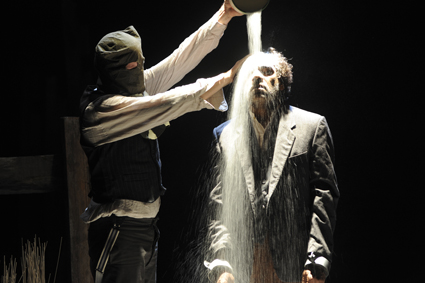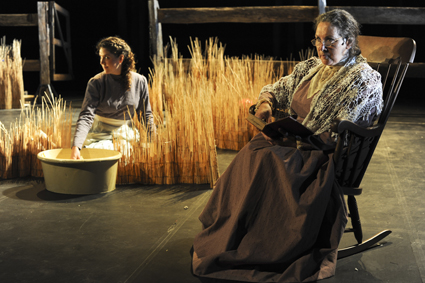all that remains
bryoni trezise: my darling patricia, posts in the paddock

Sam Routledge, LeRoy Parsons, Posts in the Paddock
photo Heidrun Löhr
Sam Routledge, LeRoy Parsons, Posts in the Paddock
THE NOW NOTORIOUS HISTORY OF ABORIGINAL ‘BUSHRANGER’ JIMMY GOVERNOR FIRST ENTERED POPULAR IMAGINATION WITH THOMAS KENEALLY’S 1972 NOVEL THE CHANT OF JIMMIE BLACKSMITH, WHICH FORMED THE BASIS OF FRED SCHEPISI’S 1978 FILM OF THE SAME NAME.
In the novel, Governor the character narrates his world of dismal dispossession in a literary move that Keneally admits he wouldn’t repeat today: what perspective could a white writer possibly bring to the histories of brutality lived by one Aboriginal man, and sedimented in a near century of half-spoken myths, amnesias, wounds and falsifications laid down by colonial Australia? Whose eyes or voice might be able to speak to this history with the mindfulness that it demands?
My Darling Patricia’s depiction of this same history in Posts in the Paddock does not try to speak on behalf of anyone, excepting perhaps the untouchable nature of time itself. Posts in the Paddock brings theatre to a history that was lived and then lived-as-silence, and in doing so, brings audience bodies into breathing, sensate contact with its remains. These remains are both literal and figural as we learn, through its restrained curation of textual, visual and sonic remnants—many of which trace from testimony, object, archive or material site—that both Clare Britton (as Ethel, Jimmy’s wife) and LeRoy Parsons (as Jimmy) are direct descendants of the families whose fates were so forcefully interpolated on one day in 1900, when Governor murdered a pregnant mother and her son in a fit of rage.
Britton, co-director of My Darling Patricia, is an O’Brien, and writes in her essay accompanying the work that the murder of Elizabeth and James O’Brien at the hands of Governor has produced “a generation of Australians who were too close to the shame, the guilt and the sadness of this story.” Britton’s uncle explains that the land called Poggy on which the murders occurred has been held by generations of their family since 1889. It is now witness, as Britton explains, to “all that remains…the vertical hardwood posts of the hut, standing in the paddock like ghosts.” This land and its imagined ghosts form the basis of a work that holds a history in its starkly brutal images, in its idiomatic register and in the quiet intimacy of a shared landscape and loss that connects bloodlines, genealogies, and now audiences.
Posts in the Paddock begins as an installation. What first appear as charred tree stumps stand waiting in a pile of rubbery ash. They are the leftovers of a time brought into the present with a choir of voices that chitter-chatter and interrupt. Words are indeterminate, histories intersect and are lost. We tread carefully looking at others who are listening. Our ears and bodies are being trained, however “synthetic” this stage imprint of a real landscape may seem. Then we are out, cool in the concrete foyer, sitting in the pause between this and the next beginning.

Aunty Rhonda Dixon Grovenor, Posts in the Paddock,
photo Heidrun Löhr
Aunty Rhonda Dixon Grovenor, Posts in the Paddock,
Next we are seated looking down into the landscape we have just inhabited. Those stumps—once close, now distant—have been brought into focus by the unsuspecting connect between our bodily tactility and theirs. They are the aftermath, the scene of the crime, the wood that has stood while all else has fallen away. We watch a history unfold. Jimmy is there, installing a fence, flirting with Ethel. They rarely speak, but actions are followed. These are illustrative but also cutting: Jimmy chained to the fence, Ethel reprimanding—teasing with a bowl of food that looks like it’s for the pig trough. A dingo puppet appears (Sam Routledge as puppeteer), and in a contest with a lawnmower, the dog is ominously hanged.
These small scenarios are built to form a kind of dumbshow prologue that ends in painful climax. Jimmy and Ethel love each other and “just want to be together all the time.” Aunty Rhonda Dixon Grovenor strums their happiness with a rendition of Hank Williams’ “Hey Good Looking, What You Got Cooking?” on a ukelele. The pair marry and have a child, but looming shadows soon empty the space of warmth as Ethel desperately kneads rounds of dough. A pastoral woman strums the Christian child’s prayer “Jesus Loves the Little Children” with zealous irony. Their world becomes impossible as landowners cut them dry: “You black rubbish, you oughta be shot for marrying a white woman.” Ethel screams with anguish, “You can’t eat the air, he better come home with something.” Reeds glow, plates are smashed against police shields and balloons stretch to popping. An electric guitar wails, underscoring the parochial, the colonial and the murderous.
These early images fold out from one another, as if to infuse history with myth, fact with imagination. Their textual and visual dramaturgy interlaces nursery rhymes, letters and diaries, prayers, puppetry and animation. The Poggy posts transform into fence posts and finally glowing embers against a backdrop of what feel like 3D projections on the scrim, making Governor’s world ominously cavernous and inescapable. Throughout there is a piercing sense of disquiet broken only by momentary relief, in a slapstick ‘loony tunes’ type chase sequence, for instance. Jimmy’s inevitable execution is theatrically envisaged in the form of a drum of sugar that is poured over his head, an image reminiscent of the mournful ecstasy one might find in a Bill Viola work; his features become tremulous, almost transluscent. We see Ethel watching his ghost walk away.
The second half of Posts in the Paddock includes Britton and Parsons recounting the research and development phases of the work. The personal here is important, as much for what it factually narrates as for how it positions the makers in relation to the history in which they imagine themselves. Author Chris Healy writes that the “intercultural space of Aboriginality” in Australia is “constituted by strange and transient patterns of remembering and forgetting” (Forgetting Aborigines, UNSW Press, 2008). In this respect, something of the past remains in Britton and Parsons, whose very bodies charge an uncanny sense of repetition and return as they work to acknowledge both the tracks of remembering and forgetting that circulate this history. This is rare theatre: part remembrance, part conjecture, part mourning, part apology and part reckoning.
Performance Space: My Darling Patricia in Association with Moogahlin Performing Arts, Posts in the Paddock, artists and participants Bryony Anderson, Katie Beckett, Jenn Blake, Michelle Blakeney, Clare Britton, Nadeena Dixon, Aunty Rhonda Dixon Grovenor, Bridget Dolan, Phil Downing, Fiona Foley, Marley Grovenor, Sam James, Declan Kelly, Halcyon Macleod, Kirk Page, LeRoy Parsons, Sam Routledge, Chris Ryan, Lily Shearer, Jade Sims, Chris Twyman, Performance Space, Carriageworks, Nov 9-19, 2011
RealTime issue #107 Feb-March 2012 pg. 38






